Hand Tools, Floats And Edgers For Concreting
Always on the job somewhere are a a few square mouth shovels, a wheelbarrow or two, and a couple of rakes. At a pinch you can manage without rakes, just use the shovels, but a nice rake makes the job easy.
| ||||||
Don't ask a concreter if you can borrow a float. That's like asking a roofer for the loan of his snips. If he is a polite sort, he will only tell you to p-ss off! Like most tools, steel floats do a good job only as long as they are looked after. Once they are twisted or kinked they are useless for finishing. The galv. bucket is always handy, they last for years if you keep them clean and can be filled up with concrete without fear of them breaking like plastic buckets do. | ||||||
On the right is a hand edging tool, about 100mm wide, and below right is a similar one that can be fixed to an extending aluminium handle. Sometimes called a walking edger It seems to me that maybe I should be calling both of these tools bull nose edgers, because they have a decent curve to the edge. Smaller ones only have something like a 6mm radius. Using these it is essential to run them along the edges fairly soon to push the aggregate down.
When using a jointer, you have to lay a straightedge, like a board or a screed on the surface of the wet concrete to give you something to work to. It is impossible to make it look good working freehand. | ||||||
If the handle is twisted anticlockwise you will see that the edge nearest the operator will lift up. When twisted the other way the other edge will lift up. If the concrete is a touch on the dry side, a trick that sometimes helps to bring the moisture and fat to the surface, is to jig it backwards and forwards to work the surface. This leaves a series of ripples, which are easily leveled with a couple of smooth strokes. Another thing that I have seen done is to add a bit more weight to the float in the form of a couple of bricks, but only when the stuff is going off fast and things get a bit desperate. | ||||||
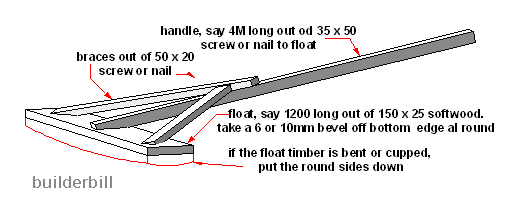 Concrete tools - Sketch of home made bullfloat Here's a sketch of a home made bullfloat that I have made quite a few times, when I have had to do my own concrete finishing. Usually a length of ceiling batten for handle and softwood for the float itself. Mostly I nailed them together and threw them away after the job was finished.(used the batten on a ceiling most like). That's why I needed the braces on them, but if I had to do a few days work with one I might make something a little more permanent. Lay the float timber on a flat surface and rest the handle on it, get a mate to hold the end of the handle (or pack it up) just above waist height. Use a bit of scrap to scribe the cut. It will be a fairly long raking cut but you don't have to be too fussy. In use, pushing away from you hold the thing about knee height so that the front edge is up a bit. Coming back, hold it about head height. If the site is clear it is simply a question of walking backwards and forwards. Easy peasy! Don't think that this is in any way inferior to the bull floats shown on these pages. It does just the same job. The timber one in some cases is better than the mag one, not quite as much bleed water is brought to the surface and so it is better under certain conditions. (Air entrained concrete, cold climate stuff). The shop bought ones have convenience built in. The handle extends, the head is detachable for easy storage, the blade can be tilted. So if with your home made one you are cramped for space in an area, cut it shorter or make another. If you have a footpath to do that is 1100 wide, make on to suit. |
A screed can of course be any material, as long as it is straight. One man screeds of necessity have to be light, so pine timber is OK, with aluminium box section as the favourite. In use the screed is tilted slightly with the leading edge raised a few mm. This gives a smoother surface to the concrete. When I first worked on a concrete job as a formwork carpenter in the early sixties aluminium screeds were unheard of. We had to select or make straight lengths of timber, say 150 x 50 for the concreters. The screed was invariably rested on the top of the formwork with a man at each end. Quite often we would have vertical bits of dowel as handles at the ends. The technique was to tamp the screed up and down on the top of the wet concrete surface, leaving a row of ripples. This compacted to surface and brought the water and fine to the top. Then a sideways traverse with a sawing backwards and forwards movement leveled it off. | |
Smaller versions are available, with single phase electric motors, driving smaller shafts. You would maybe hire or buy one of these if you were doing some small pre-casting work. The last time I used one was on a purpose built polished concrete wash trough. The small needle vibrator got down into the thin wall sections and did a good job. | |
 Concrete tools - Power float or helicopter steel float, commonly called a helicopter. These are again always about the same size. They have lifting handles at each side, and it takes two men to place them on the slab, carefully. The motor has an automatic clutch, so that when it is started, the blades do not move until the revs are increased. With the handle held level it is possible to walk forward and backwards. Lift the handle slightly and the machine moves to the left (opposite direction to the blades travel) and lower the handle and it goes right. Experienced hands always have a laugh at the expense of guys handling one of these for the first time. It is a definite skill, but does not take too long to pick up. Just don't practice near an edge that could damage the machine if it went off. The blades are adjusted by a small handle that when spun round, lifts or lowers the steel blades. Have them higher at the beginning, and as the surface hardens, lower them for a denser and more compact shiny finish. Note, the guy in the photo is doing a final float with a bucket of water and a sponge to put a drop of water now and again to help him polish out imperfections. This was in the middle of an extremely hot day, but he should not have been doing it. Adding water to aid in floating can make the finished surface flaky or powdery. |
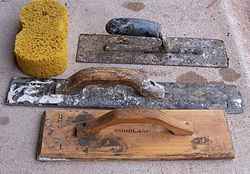
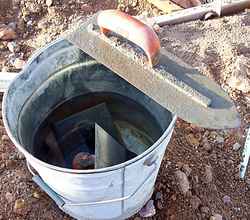
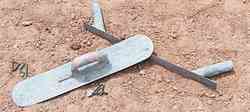
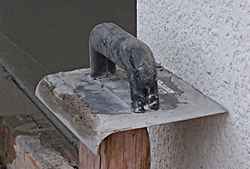
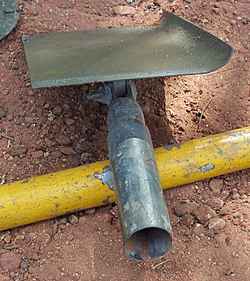
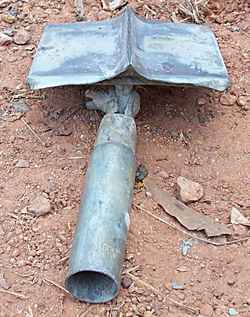
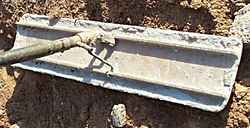

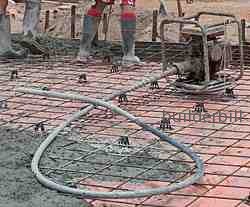
Enjoyed the journey. loved looking at the old used tools...wish I would have kept all mine. www.apearms.com
উত্তরমুছুনI read your blog, its best and useful information for us
উত্তরমুছুনbusiness consulting services oman
GTAcrete is the Best Concrete Contractors Toronto And GTA
উত্তরমুছুনGTAcrete is the top concrete contractors Toronto which offers efficient installation and maintenance services. We cover every aspect of our service to help clients.
Try asking people on the brink of you like co-workers, friends, or maybe neighbors if they know good contractors. attempt to examine yourself the concrete work that the contractor did for them. Try examining its appearance, the length of your time it had been wiped out reference to the time once you have done your checking, and therefore the present shape that the concrete is in. If the aforesaid individuals are satisfied with the contracted concrete project, then try contacting that very same concrete contractor and arrange a gathering .
উত্তরমুছুনRoseville Concrete Contractor
Before cutting concrete, it is necessary to determine the type of building material, especially if you are using a grinder with a disc. Therefore, first check the thickness of the surface to be treated. If the cutting depth is about 10 cm or more, then the diamond wheel on concrete is likely to stumble upon reinforcement, so you need to choose more durable cutting discs from midlandsitesupplies.
উত্তরমুছুনCement or concrete tools are most commonly used for placing concrete correlated with every part of the finishing operation. Each tool has its own key quality components and works on its own to get the job done right. Once the concrete has been wholly poured all over the surface, all its air pockets are present in between. Then it is the ultimate time for you to get your desired smooth finishing.
উত্তরমুছুনAs the name indicates, “Construction Machinery” is a term used as a familiar name for several heavy vehicles. In addition to that, it is also used for equipment that is mainly designed to perform different construction tasks . Those tasks may either be related to constructing houses, roads, offices, and many more. Such heavy machines are also used somehow in the mining industry.
উত্তরমুছুনIt is usually defined as a process that radically strived to create a durable and smooth surface made of concrete. The timing of the concrete finishing is an extremely crucial thing. So, you must always pay close attention to concrete type and its condition. Improper finishing or utilizing inappropriate ending techniques usually result in unattractive, weak, and damaged surfaces.
উত্তরমুছুনThank you so much for sharing this informative post. Really i got exact information what i was searching concrete paver molds to know about our service.
উত্তরমুছুন